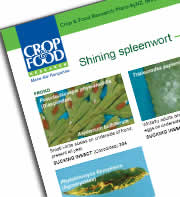|
|
Plant-SyNZ™ names
Names used for invertebrates and plants
in Plant-SyNZ™ database
A plant or animal can have several names, a scientific name, a
common or vernacular name or a Maori name. Where there is no scientific
name, they may have an informal "tag" name.
Scientific names
Scientific names are given to plants and animals that have been
formally described in scientific literature.
The scientific names used in Plant-SyNZ™ are those in the
Landcare Research Bugs (invertebrates)
and Flora databases
and they provide the links between the three databases. In addition,
Plant-SyNZ™ contains scientific names of plants that
are not in the Flora database. These are either species that
do not occur in New Zealand or are some species of cultivated plants.
Plant-SyNZ™ also
includes names of insects and mites that are not in the NZBugs
database. These include species that are not in New Zealand and
names for undescribed taxa.
Synonyms. Sometimes the scientific name of a
species changes as a result of new information. The old name is
called a synonym. The current valid name for a synonym can be
found in the Flora and Bugs databases. The valid scientific name
will provide a link to Plant-SyNZ™.
See tag names below for names
used for species that have not been formally described.
Sometimes a specimen can only be identified to a genus. In the
database it is named as Genus sp., e.g. Pittosporum sp.
or Liriomyza sp.
For more information about scientific names see below.
Common or vernacular names
Common or vernacular names are not used in Plant-SyNZ™, because
there can be more than one common name for a species or the same
common name may refer to more than one species. However, common
or vernacular names can be found in the NZFlora database [link
to flora] and a direct link enables them to be used with the Plant-SyNZ™ database.
[check insect common names list]
Maori names
Maori names are not used in Plant-SyNZ™, because there can be more
than one Maori name for a species or the same Maori name may refer
to more than one species. However, Maori names can be found in
the Flora database [link to flora] and a direct link enables them
to be used with the Plant-SyNZ™ database. [check insect Maori
names list]
Tag names
Some plants and animals that are recognised as belonging to distinct
species have not received a formal description. Tag names are
used so that information about the species can be referred to in
publications and databases. Two forms of tag names are used in
Plant-SyNZ™.
Genus known, species undescribed. Where the
genus is known, the format is Genus sp. "tag name" (Author year),
i.e. for the leaf mining fly reared from Hydrocotyle species, Liriomyza sp.
"hydrocotyle" (Spencer 1976) and for the leaf mining fly reared
from Melicytus alpine, Liriomyza sp. "Melicytus
alpina" of Martin 2000. The first species was first mentioned
by Spencer in a 1976 publication, while the second species has
not been recorded in a publication.
Genus unknown, species undescribed. Where the
genus is unknown and the species undescribed two conventions have
been followed.
The first is as follows, Gen. nov. "tag name" sp. "tag name" of
author year, e.g. Gen. nov. "Greenthrips" sp. "Hunua" of Martin
2009.
The second convention is used mainly for species of gall forming
insects and mites where a longer description of gall type is useful
and biologically meaningful. [check with Trevor on this format].
The following examples illustrate the concept.
Coprosma small bud gall sp. areolata of Martin 1999
Coprosma shoot tip gall sp. areolata of Martin 2001
Olearia small leaf blister gall sp. albida of Martin 2005
Scientific names, an explanation
The scientific name for a species consists of two parts, a generic
name and a specific epithet. The generic name always starts with
a capital letter while the specific epithet is never capitalised
even if it based on the name of a place or person. The scientific
name is always italicized or underlined, e.g. Thrips obscuratus or Thrips
obscuratus.
The scientific name may be followed by the name of the person(s)
who originally described the species. The persons (authors) name
is never italicized or underlined. If after the original description,
the species is moved to a different genus, the original authors
name is enclosed by brackets, e.g. Thrips obscuratus (Crawford).
For plants the convention is that when a species is moved to a
different genus, the persons name who makes the change is also
added, e.g. Ranunculus membranifolius (Kirk) Garnock-Jones.
Animal names can also include the year when a species was originally
described, e.g. Thrips obscuratus (Crawford, 1941).
In addition to the basic scientific name, there are various additional
subdivisions. For example a genus may be divided into two or more
subgenera. The subgenus name is inserted between
the generic name and the specific epithet. Species themselves
can also be subdivided. These subdivisions can include, subspecies (spp.), varieties (var.), forms (f.),
and cultivars (cv.).
A species is a human concept for biological entities. Over time
ideas about the definition of a species and its relationship to other
species may change, hence the movement of species to other genera
or if two "species" are later believed to be the same, the joining
(synonymising) of the two names. When this happens the oldest name
is retained. In order to provide a reference for each species, type
specimens are designated. The most important are the holotype which
is a single specimen selected and designated at the time of the original
description, and the paratypes, which are any specimens
from the original series of specimens from which a description was
prepared.
Contacts/Feedback
 |
PDFs can be viewed
using Adobe Reader. |
|


